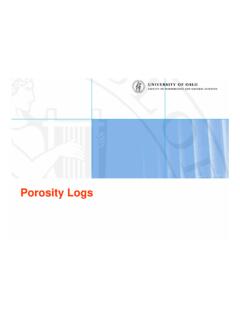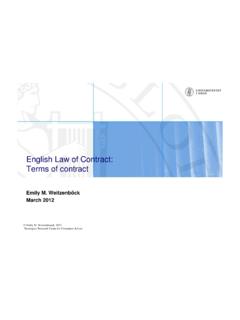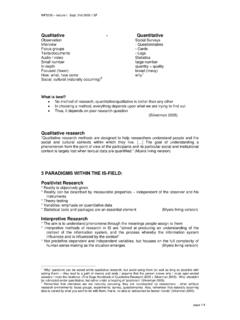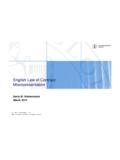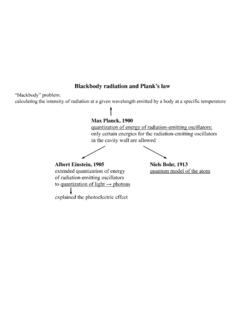Transcription of Porosity Logs - UiO
1 Porosity Logs General Type of Porosity logs Sonic log Density log Neutron log None of these logs measure Porosity directly The density and neutron logs are nuclear measurements The sonic log use acoustic measurements A combination of these logs gives good indications for lithology and more accurate estimates of Porosity Sonic log General Sonic A log that measures interval transit time ( t) of a compressional sound wave travelling through the formation along the axis of the borehole The acoustic pulse from a transmitter s detected at two or more receivers. The time of the first detection of the transmitted pulse at each receiver is processed to produce t. The t is the transit time of the wave front over one foot of formation and is the reciprocal of the velocity Interval transit time is both dependent on lithology and Porosity Sonic log is usually displayed in track 2 or 3.
2 Units: sec/ft, sec/m Mnemonics: DT, AC. Symbol: . General Sonic Interpretation goals: Porosity Lithology identification (with Density and/or Neutron). Synthetic seismograms (with Density). Formation mechanical properties (with Density). Detection of abnormal formation pressure Permeability identification (from waveform). Cement bond quality Sonic Porosity Formula From the Sonic log, a sonic derived Porosity log (SPHI) may be derived: Wyllie Time-average t t matrix . s = log . t f t matrix . Raymer-Hunt-Gardner 5 t t matrix . s = log . 8 t log .. For unconsolidated formations t t matrix 1 t C. s = log , with Cp = sh t f t matrix Cp 100. Hydrocarbon effects: This requires a formation matrix The Dt is increased due to HC.
3 Transit time to be known therefore: SPHI Units: percent, fraction = s x (gas). Cp = Compaction factor = s x (oil). C = constant, normally Sonic Porosity Charts Sonic Porosity tma ( s/ft) tma ( s/m). Vma (ft/sec) Vma (m/s) tma ( s/ft) tma ( s/m) commonly commonly used used Sandstone 18 - 51 182 167 or 51 182 or 167. Limestone 21 23 156 143 156. Dolomite 23 143 143. Anhydrite 20 50 164 50 164. Salt 15 219 67 220. Freshwater 189 620 189 620. mud filtrate Saltwater mud 185 607 185 607. filtrate Gas 920 3018 920 3018. Oil 230 755 230 755. Casing (iron) 57 187 57 187. Sonic Secondary Effects Environmental effects: Enlarged borehole, formation fractures, gas in the borehole or formation, or improper centralization can produce signal attenuation resulting in cycle skipping or DT spikes to higher values Improper centralization, lack of standoff, or excessive logging speed can result in road noise , or DT spikes to either higher or lower values Interpretation effects: Lithology: Porosity calculated from sonic depends on the choice of matrix transit time, which varies with lithology Porosity calculations for uncompacted formations may yield Porosity values higher than the actual values when using the Wyllie equation.
4 Use instead the Raymer-Hunt-Gardner equation or correct for decompaction Porosity calculated in gass bearing zones will be slightly higher than the actual values because the traveltime in gass is higher than in water Density Log General Density Gamma rays emitted from a chemical source (Ce137, Co60). interact with electrons of the elements in the formation. Two detectors count the number of returning gamma rays which are related to formation electron density For most earth materials, electron density is related to formation density through a constant Returning gamma rays are measured at two different energy levels High energy High energy gamma rays ( compton scattering ) determine bulk density and compton scattering therefore Porosity Low energy gamma rays (due to photoelectric effect) are used to determine formation lithology Low energy gamma rays are Low energy related to the lithology and show little dependence on Porosity and Photoelectric absorption fluid type Symbol for density: (rho).
5 General Density Bulk Density: Units: g/cm3, kg/m3. Mnemonics: RHOB, DEN, (ZDEN). Density Porosity : Units: %, v/v decimal Mnemonics: DPHI, PHID, DPOR. Density Correction: Units: g/cm3, kg/m3. Mnemonics: DRHO. Photoelectric effect: Units: b/e (barns per electron) . Mnemonics: PE, Pe, PEF. A barn is a unit of area, abbreviated mostly as "bn or b , equal to 10 28. m2. Although not an official SI unit, it is widely used by nuclear physicists, since it is convenient for expressing the cross sectional area of nuclei and nuclear reactions. A barn is approximately equal to the area of a uranium nucleus General Density Interpretation goals Porosity Lithology identification (from PEF and/or with Sonic and/or Neutron).
6 Gas indication (with Neutron). Synthetic seismograms (with Sonic). Formation mechanical properties (with Sonic). Clay content (shaliness)(with Neutron). Density Porosity Formula Formation bulk density ( b). is a function of matrix density ( ma), Porosity and formation fluid density ( f). Density Porosity is defined as: ma b den =. ma f The matrix density and the fluid density need to be known Density Porosity Chart Density Porosity Matrix density Fluid density PEF (b/e). (g/cm3) (g/cm3). Sandstone Limestone Dolomite Anhydrite Halite Coal ~ Barite 267. Gas Oil ~ Water Density Secondary Effects Environmental effects: Enlarged borehole: RHOB < Fm. Bulk Density (DPHI > PHIactual). Rough borehole: RHOB < Fm.
7 Bulk Density (DPHI > PHIactual). This is due to the sensor pad losing contact with the borehole wall. Other indications for a rough borehole will be highly variable Caliper curve, and a high-valued density correction (DRHO). Barite muds: RHOB > Fm. Bulk Density (DPHI < PHIactual) and PEF. > PEFactual Interpretation effects: Lithology: Porosity calculated from density depends on the choice of matrix density, which varies with lithology (DPHI might be negative). Fluid content: Porosity calculated from density depends on the choice of fluid density, which varies with fluid type and salinity. In routine calculations, zone of investigations is assumed to be 100%. filled with mud filtrate Hydrocarbons: Presence of gas (light HC) in the pore space causes DPHI to be more than the actual Porosity .
8 In Density-Neutron combinations, this causes a cross-over , where the NPHI values are less than the DPHI values In all three cases above, the RHOB value from the tool is correct, but the calculated DPHI is erroneous Neutron Log General Neutron Neutron logs measure the hydrogen content in a formation. In clean, shale free formations, where the porosoty is filled with water or oil, the neutron log measures liquid filled Porosity ( N, PHIN, NPHI). Neutrons are emitted from a chemical source (americium . beryllium mixture). At collision with nuclei in the formation, the neutrons loses energy. With enough collisions, the neutron is absorped and a gamma ray is emitted Since a neutron is slightly heavier than a proton, the element which closely approximates the mass of a neutron is hydrogen.
9 In neutron-hydrogen collisions the average energy transfers to the hydrogen nucleus is about that of the energy originally contained in the neutron. Whereas, if the scattering nucleus was oxygen (mass 16 amu) the neutron would retain 77% of its energy Materials with large hydrogen content like water or hydrocarbons become very important for slowing down Since hydrogen in a porous formation is concentrated in the fluid-filled pores, energy loss can be related to the formation's Porosity General Neutron Neutron curves commoly displayed in track 2 or 3. Displayed as Neutron Porosity (NPHI, PHIN, NPOR). Units: Porosity units ( ). (calibrated with a standard, different for all tools), v/v decimal, fraction or %.
10 Neutron logs are not calibrated in basic physical units. Therefore, specific logs need to be interpreted with specific charts General Neutron Interpretation goals: Porosity (displayed directly on the log). Lithology identification (with Sonic and Density). Gas indication (with Density). Clay content, shaliness (with Density). Correlation, especially in cased holes Neutron Porosity Secondary Effects Environmental effects: Enlarged borehole: NPHI > PHIactual Mudcake: NPHI < PHIactual Borehole salinity: NPHI < PHIactual Formation salinity: NPHI > PHIactual Mud weight: NPHI < PHIactual Pressure: NPHI > PHIactual Temperature: NPHI < PHIactual Pressure and temperature have the greatest effect. Neutron less affected by rough borehole Interpretation effects: Shaliness: NPHI > PHIactual in shaly zones Gas: NPHI < PHIactual in gassy zones.
